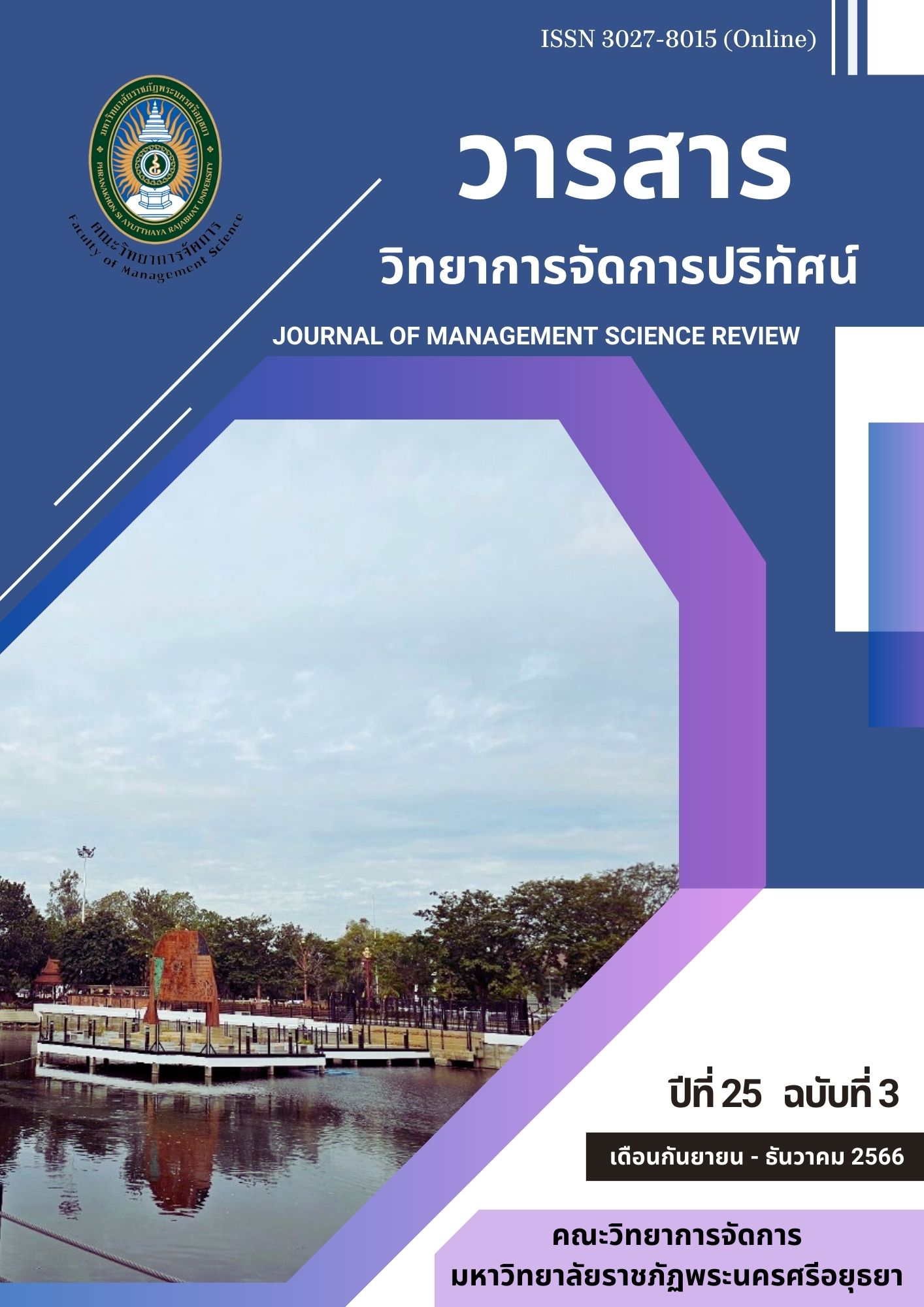การลงทุนโดยตรงในต่างประเทศของจีน: ความสัมพันธ์ระหว่างปัจจัยโครงสร้างประชากรกับ OFDI เมื่อจีนก้าวสู่สังคมสูงวัย
คำสำคัญ:
การลงทุนโดยตรง, จีน, โครงสร้างประชากร, สังคมสูงวัยบทคัดย่อ
งานวิจัยนี้มีวัตถุประสงค์เพื่อ 1) หาความสัมพันธ์ระหว่างปัจจัยด้านโครงสร้างประชากรกับมูลค่าการลงทุนโดยตรงในต่างประเทศของจีน 2) ศึกษามูลค่าการลงทุน ประเภทธุรกิจที่ไปลงทุน และประเทศที่เข้าไปลงทุน เป็นการวิจัยเชิงปริมาณโดยใช้ Pearson Correlation ทดสอบความสัมพันธ์ อ้างอิงข้อมูลสถิติราชการจีน และมีการวิจัยเชิงคุณภาพโดยใช้การศึกษาเอกสาร
ผลการศึกษาพบว่าปัจจัยที่มีความสัมพันธ์ในทิศทางเดียวกันกับมูลค่าการลงทุนโดยตรงของจีน (Outward Foreign Direct Investment- OFDI) คือ 1) จำนวนประชากรสูงวัย 2) รายได้โดยเฉลี่ยต่อครัวเรือน 3) จำนวนประชากรในเมือง 4) ระดับการศึกษาปริญญาตรี 5) สวัสดิการจากภาครัฐ 6) แรงงานในภาคบริการ ส่วนปัจจัยที่มีความสัมพันธ์ในทิศทางตรงกันข้ามกับมูลค่าการลงทุนโดยตรงของจีนคือ 1) จำนวนคนในชนบท 2) ระดับการศึกษามัธยมศึกษาตอนปลายและตอนต้น โดยมูลค่าการลงทุนในช่วงปี 2010-2021 เพิ่มขึ้นทุกปี เฉลี่ย 1,307.63 พันล้านดอลลาร์สหรัฐต่อปี สำหรับประเภทธุรกิจที่มีการลงทุนมาก ได้แก่ 1) ธุรกิจการเช่าและให้บริการทางธุรกิจ 2) ธุรกิจค้าส่งและค้าปลีก 3) ธุรกิจผลิต 4) ธุรกิจตัวกลางทางการเงิน และ 5) ธุรกิจขนส่ง คลังสินค้าและไปรษณีย์ภัณฑ์ จีนเข้าไปลงทุนในประเทศต่างๆเกือบทุกภูมิภาคของโลก โดยเข้าไปลงทุนมากที่สุดในเขตปกครองพิเศษฮ่องกง, รองลงมาคือหมู่เกาะบริติชเวอร์จิน และหมู่เกาะเคย์แมน สำหรับในกลุ่มอาเซียนจีนมีการลงทุนโดยตรงมากที่สุดในสิงคโปร์ รองลงมาคือ อินโดนีเซียและเวียดนาม
เอกสารอ้างอิง
Attanasio, O. P. & Violante, G.L. (2000). The Demographic Transition in Closed and Open Economies: A Tale of Two Regions. Retrieved from https://publications.iadb.org/publications/english/viewer/The-Demographic-Transition-in-Closed-and-Open-Economies-A-Tale-of-Two-Regions.pdf
Bloom, D.E. & Finlay, J.E. (2009). Demographic change and economic growth in Asia. Asian Economic Policy Review, 4(1), 45-64. Retrieved from https://www.hsph.harvard.edu/wp-content/uploads/sites/1288/2013/10/PGDA_WP_41.pdf
Börsch-Supan, A. (1995). The impact of population aging on savings, investment and growth in the OECD area. Discussion Papers 512. Institut für Volkswirtschaftslehre und Statistik, No.512-95
Brooks, Robin Jermyn. (2003). Population Aging and Global Capital Flows in a Parallel Universe. IMF Staff Papers 50. Washington, DC: International Monetary Fund, 200-221.
Buckley, P. J., Clegg, L. J., Cross, A. R., Liu, X., Voss, H., & Zheng, P. (2007). The Determinants of Chinese Outward Foreign Direct Investment. Journal of International Business Studies, 38, 499-518.
Dunning, J.H. (1993). Multinational Enterprises and the Global Economy, Addison-Wesley, Wokingham. EUCCC (European Union Chamber of Commerce in China) (2017), China Manufacturing 2025: Putting Industrial Policy Ahead of Market Forces, EUCCC, Beijing
Fälth, J. (2021). Aging Populations and FDI Outflows - Exploring the effects of increasingly older populations on present and future levels of foreign direct investment. [Master’s Thesis]. Lund University. Retrieved form http://lup.lub.lu.se/student-papers/record/9068255
Foundation of Thai Gerontology Research and Development Institute (TGRI). (2020). Situation of The Thai Elderly 2019. Nakhon Pathom: Institute of Population and Social Research Mahidol University. Retrieved from https://www.dop.go.th/download/knowledge/th1610945020-322_0.pdf
Fuest, C., Hugger, F., Sultan, S. and Xing, J. (2019). Chinese acquisitions abroad: are they different?. CESifo , Center for Economic Studies & Ifo Institute, (7585)
Gao, C., Zhang, D., Cao, M. & Wen, Y. (2021). How does Human Capital Heterogeneity Affect Chinese Enterprises' Direct Investment in Africa?. Preprints. doi: 10.20944/preprints202111. 0075.v1
Kolstad, I. & Wiig, A. (2012). What determines Chinese outward FDI?. Journal of World Business, 47, 26-34. Retrieved from https://doi.org/10.1016/j.jwb.2010.10.017
Lyu, J.X. & Sun, W.K. (2015). Population Aging, Pension Funds and International Capital Flows: Mechanism and Empirical Research. Economic Theory and Business Management, 10, 20-34.
Ma, Y. (2022). Research on the Mechanism of Demographic Structure on China's Outward Foreign Direct Investment. Frontiers in Business, Economics and Management, 4(2), 168-171.
Office of the Leading Group of the State Council for the Seventh National Population Census. (2020) Major Figures on 2020 China population census, China Statistic Press.
Taengphet, C. & Wongurai, W. (2017). FAQ Focused and Quick Investment Paths from Dragon Land Issue 116. Bank of Thailand. 1-8. Retrieved from https://content.botlc.or.th/mm-info/BOTCollection/BOTFAQ/FAQ116.pdf
Tantivisethsak, P. & Na Ubon, A. . (2018). Factors Affecting China’s FDI in Thailand in Comparison with Other ASEAN Countries during 2000 – 2016. Suthiparithat, 32(104), 169–182. Retrieved from https://so05.tci-thaijo.org/index.php/DPUSuthiparithatJournal/article/view/243345
Wheelen T.L. & Hunger J.D. (2018). Strategic Management and Business Policy 15e. n.p.: Pearson Education.
Xia, J., Ma, X., Lu, J. W., & Yiu, D. W. (2014). Outward Foreign Direct Investment by Emerging Market Firms: a Resource Dependence Logic. Strategic Management Journal, 35(9), 1343–1363. Retrieved from: http://www.jstor.org/stable/24037344
Yang, J.-H., Wang, W., Wang, K.-L. & Yeh, C.Y. (2018). Capital intensity, natural resources, and institutional risk preferences in Chinese Outward Foreign Direct Investment. International Review of Economics and Finance, 55, 259-272. Retrieved form https://doi.org/10.1016/j.iref.2017.07.015
Zhao, J., & Lee, J. (2020). The Belt and Road Initiative, Asian infrastructure investment bank, and the role of enterprise heterogeneity in China’s outward foreign direct investment. Post-communist Economies, 33(4), 1-23. Retrieved form DOI: 10.1080/14631377.2020.1745560





